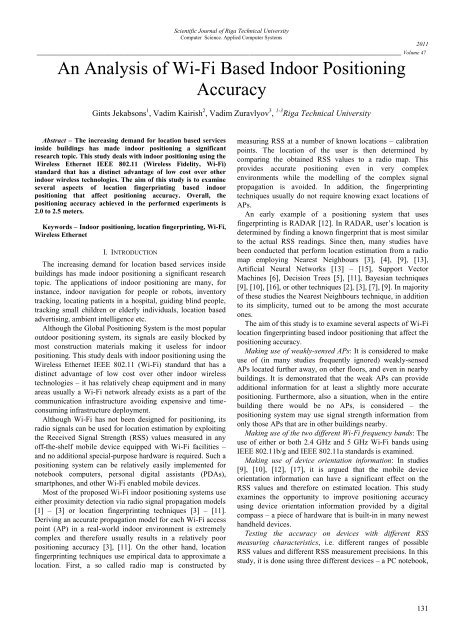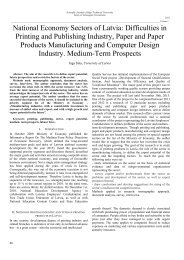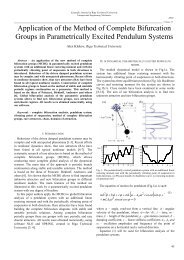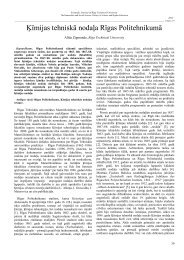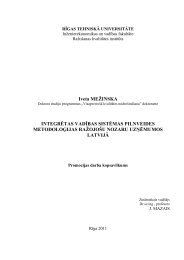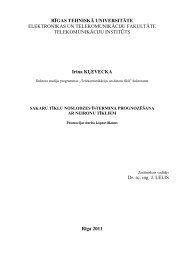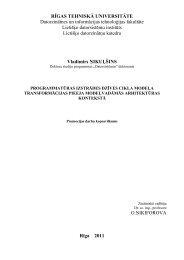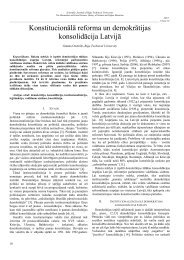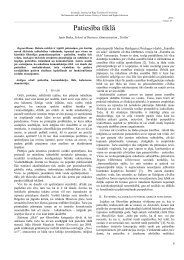An Analysis of Wi-Fi Based Indoor Positioning Accuracy - ortus
An Analysis of Wi-Fi Based Indoor Positioning Accuracy - ortus
An Analysis of Wi-Fi Based Indoor Positioning Accuracy - ortus
Create successful ePaper yourself
Turn your PDF publications into a flip-book with our unique Google optimized e-Paper software.
Scientific Journal <strong>of</strong> Riga Technical University<br />
Computer Science. Applied Computer Systems<br />
________________________________________________________________________________________________ Volume 47<br />
<strong>An</strong> <strong>An</strong>alysis <strong>of</strong> <strong>Wi</strong>-<strong>Fi</strong> <strong>Based</strong> <strong>Indoor</strong> <strong>Positioning</strong><br />
<strong>Accuracy</strong><br />
Gints Jekabsons 1 , Vadim Kairish 2 , Vadim Zuravlyov 3 , 1-3 Riga Technical University<br />
Abstract – The increasing demand for location based services<br />
inside buildings has made indoor positioning a significant<br />
research topic. This study deals with indoor positioning using the<br />
<strong>Wi</strong>reless Ethernet IEEE 802.11 (<strong>Wi</strong>reless <strong>Fi</strong>delity, <strong>Wi</strong>-<strong>Fi</strong>)<br />
standard that has a distinct advantage <strong>of</strong> low cost over other<br />
indoor wireless technologies. The aim <strong>of</strong> this study is to examine<br />
several aspects <strong>of</strong> location fingerprinting based indoor<br />
positioning that affect positioning accuracy. Overall, the<br />
positioning accuracy achieved in the performed experiments is<br />
2.0 to 2.5 meters.<br />
Keywords – <strong>Indoor</strong> positioning, location fingerprinting, <strong>Wi</strong>-<strong>Fi</strong>,<br />
<strong>Wi</strong>reless Ethernet<br />
I. INTRODUCTION<br />
The increasing demand for location based services inside<br />
buildings has made indoor positioning a significant research<br />
topic. The applications <strong>of</strong> indoor positioning are many, for<br />
instance, indoor navigation for people or robots, inventory<br />
tracking, locating patients in a hospital, guiding blind people,<br />
tracking small children or elderly individuals, location based<br />
advertising, ambient intelligence etc.<br />
Although the Global <strong>Positioning</strong> System is the most popular<br />
outdoor positioning system, its signals are easily blocked by<br />
most construction materials making it useless for indoor<br />
positioning. This study deals with indoor positioning using the<br />
<strong>Wi</strong>reless Ethernet IEEE 802.11 (<strong>Wi</strong>-<strong>Fi</strong>) standard that has a<br />
distinct advantage <strong>of</strong> low cost over other indoor wireless<br />
technologies – it has relatively cheap equipment and in many<br />
areas usually a <strong>Wi</strong>-<strong>Fi</strong> network already exists as a part <strong>of</strong> the<br />
communication infrastructure avoiding expensive and timeconsuming<br />
infrastructure deployment.<br />
Although <strong>Wi</strong>-<strong>Fi</strong> has not been designed for positioning, its<br />
radio signals can be used for location estimation by exploiting<br />
the Received Signal Strength (RSS) values measured in any<br />
<strong>of</strong>f-the-shelf mobile device equipped with <strong>Wi</strong>-<strong>Fi</strong> facilities –<br />
and no additional special-purpose hardware is required. Such a<br />
positioning system can be relatively easily implemented for<br />
notebook computers, personal digital assistants (PDAs),<br />
smartphones, and other <strong>Wi</strong>-<strong>Fi</strong> enabled mobile devices.<br />
Most <strong>of</strong> the proposed <strong>Wi</strong>-<strong>Fi</strong> indoor positioning systems use<br />
either proximity detection via radio signal propagation models<br />
[1] – [3] or location fingerprinting techniques [3] – [11].<br />
Deriving an accurate propagation model for each <strong>Wi</strong>-<strong>Fi</strong> access<br />
point (AP) in a real-world indoor environment is extremely<br />
complex and therefore usually results in a relatively poor<br />
positioning accuracy [3], [11]. On the other hand, location<br />
fingerprinting techniques use empirical data to approximate a<br />
location. <strong>Fi</strong>rst, a so called radio map is constructed by<br />
2011<br />
measuring RSS at a number <strong>of</strong> known locations – calibration<br />
points. The location <strong>of</strong> the user is then determined by<br />
comparing the obtained RSS values to a radio map. This<br />
provides accurate positioning even in very complex<br />
environments while the modelling <strong>of</strong> the complex signal<br />
propagation is avoided. In addition, the fingerprinting<br />
techniques usually do not require knowing exact locations <strong>of</strong><br />
APs.<br />
<strong>An</strong> early example <strong>of</strong> a positioning system that uses<br />
fingerprinting is RADAR [12]. In RADAR, user’s location is<br />
determined by finding a known fingerprint that is most similar<br />
to the actual RSS readings. Since then, many studies have<br />
been conducted that perform location estimation from a radio<br />
map employing Nearest Neighbours [3], [4], [9], [13],<br />
Artificial Neural Networks [13] – [15], Support Vector<br />
Machines [6], Decision Trees [5], [11], Bayesian techniques<br />
[9], [10], [16], or other techniques [2], [3], [7], [9]. In majority<br />
<strong>of</strong> these studies the Nearest Neighbours technique, in addition<br />
to its simplicity, turned out to be among the most accurate<br />
ones.<br />
The aim <strong>of</strong> this study is to examine several aspects <strong>of</strong> <strong>Wi</strong>-<strong>Fi</strong><br />
location fingerprinting based indoor positioning that affect the<br />
positioning accuracy.<br />
Making use <strong>of</strong> weakly-sensed APs: It is considered to make<br />
use <strong>of</strong> (in many studies frequently ignored) weakly-sensed<br />
APs located further away, on other floors, and even in nearby<br />
buildings. It is demonstrated that the weak APs can provide<br />
additional information for at least a slightly more accurate<br />
positioning. Furthermore, also a situation, when in the entire<br />
building there would be no APs, is considered – the<br />
positioning system may use signal strength information from<br />
only those APs that are in other buildings nearby.<br />
Making use <strong>of</strong> the two different <strong>Wi</strong>-<strong>Fi</strong> frequency bands: The<br />
use <strong>of</strong> either or both 2.4 GHz and 5 GHz <strong>Wi</strong>-<strong>Fi</strong> bands using<br />
IEEE 802.11b/g and IEEE 802.11a standards is examined.<br />
Making use <strong>of</strong> device orientation information: In studies<br />
[9], [10], [12], [17], it is argued that the mobile device<br />
orientation information can have a significant effect on the<br />
RSS values and therefore on estimated location. This study<br />
examines the opportunity to improve positioning accuracy<br />
using device orientation information provided by a digital<br />
compass – a piece <strong>of</strong> hardware that is built-in in many newest<br />
handheld devices.<br />
Testing the accuracy on devices with different RSS<br />
measuring characteristics, i.e. different ranges <strong>of</strong> possible<br />
RSS values and different RSS measurement precisions. In this<br />
study, it is done using three different devices – a PC notebook,<br />
131
Scientific Journal <strong>of</strong> Riga Technical University<br />
Computer Science. Applied Computer Systems<br />
________________________________________________________________________________________________ Volume 47<br />
<strong>Fi</strong>g. 1. The two phases <strong>of</strong> location fingerprinting<br />
a smartphone, and a Pocket PC PDA.<br />
In many existing studies, to perform the positioning<br />
experiments, (usually) three to six APs are carefully<br />
distributed across the area <strong>of</strong> interest specifically for the<br />
purposes <strong>of</strong> the experiments. Therefore, it should be noted that<br />
in the experiments <strong>of</strong> this study no additional APs were<br />
deployed and no existing APs were moved – the experiments<br />
are performed using an already existing infrastructure with<br />
APs that have been deployed for maximum <strong>Wi</strong>-<strong>Fi</strong> internet<br />
availability.<br />
The remainder <strong>of</strong> this paper is organized as follows: Section<br />
2 outlines location fingerprinting, describes Weighted<br />
k-Nearest Neighbours algorithm and sketches the idea <strong>of</strong> the<br />
usage <strong>of</strong> device orientation information. Section 3 describes<br />
the developed s<strong>of</strong>tware. Section 4 describes the performed<br />
experiments and presents experimental results and findings.<br />
<strong>Fi</strong>nally, Section 5 concludes the paper.<br />
A. Location fingerprinting<br />
132<br />
AP1<br />
AP2<br />
II. METHODOLOGY<br />
Location fingerprinting based positioning systems usually<br />
work in two phases (see <strong>Fi</strong>g. 1): calibration phase (also called<br />
<strong>of</strong>fline phase) and positioning phase (also called online phase<br />
or run-time phase). In the calibration phase, a mobile device is<br />
used to measure RSS values (in dBm) from several APs at the<br />
chosen calibration points in the area <strong>of</strong> interest. Each <strong>of</strong> the n<br />
measurements becomes a part <strong>of</strong> the radio map and is a tuple<br />
q , i 1,<br />
2,...,<br />
n q � x , y are the geographical<br />
� i ri<br />
� � where i � i i �<br />
coordinates <strong>of</strong> the ith location and � �r r ,... r �<br />
r are the m<br />
i<br />
i1,<br />
i2<br />
RSS values from m APs at that location. Usually, an average<br />
<strong>of</strong> several samples recorded per location is stored.<br />
In the positioning phase, a mobile device measures the RSS<br />
values in an unknown location and applies a location<br />
estimation algorithm to estimate its current location using the<br />
previously created radio map. As indoor environments have<br />
unique signal propagation characteristics, it can be assumed<br />
that each location can be associated with a unique combination<br />
<strong>of</strong> RSS values.<br />
B. Weighted k-Nearest Neighbours<br />
A general Weighted k-Nearest Neighbours (WKNN)<br />
algorithm for location fingerprinting can be described as a two<br />
step process. <strong>Fi</strong>rst, find within the radio map the k indices<br />
i 1 , i2,...,<br />
ik<br />
whose k i i i r , r ,..., r values are nearest (according to<br />
1 2<br />
Euclidean distance in the signal space) to the given vector r<br />
measured at the unknown location. In the second step,<br />
�<br />
APm<br />
Mobile device at<br />
calibration points<br />
Mobile device at<br />
unknown position<br />
im<br />
Calibration phase<br />
<strong>Positioning</strong> phase<br />
RSS<br />
Known position<br />
RSS<br />
Position estimate<br />
Radio<br />
map<br />
Position estimation<br />
algorithm<br />
2011<br />
calculate the estimated location q (for each coordinate<br />
separately) as an average weighted by the inverse <strong>of</strong> the RSS<br />
distances:<br />
q �<br />
k<br />
�<br />
j�1<br />
�<br />
w jq<br />
i j<br />
�1<br />
where all weights are nonnegative w j � d(<br />
ri , r)<br />
and d is the<br />
j<br />
Euclidean distance between the m-vectors. Note that there is a<br />
special case when the distance is zero; then as the estimated<br />
location just the one with the zero distance is taken without<br />
fully computing (1). The reasoning behind this algorithm is<br />
that the calibration point with the shortest distance in signal<br />
space also has the shortest distance in physical space, and as<br />
such acts as a proper location estimate.<br />
WKNN has one tuning parameter, the number <strong>of</strong> nearest<br />
neighbours considered k, which is used to control the locality<br />
<strong>of</strong> the location calculation. When k �1<br />
, the algorithm acts as<br />
a simple look-up table. For larger values, the location can also<br />
be estimated to be somewhere in-between the calibration<br />
points. Reference [18] recommends using k �1<br />
only if the<br />
density <strong>of</strong> the radio map is high. However, k should also not<br />
be too large as then the location estimates will be too much<br />
influenced by calibration points far away. In this study the<br />
number is fixed experimentally to k � 2 .<br />
k<br />
l�1<br />
C. Making use <strong>of</strong> device’s orientation information<br />
The study in [9] showed that the positioning accuracy<br />
significantly benefits from varying rotation <strong>of</strong> the measuring<br />
device during the calibration phase. This is mostly because <strong>of</strong><br />
the radio irregularity caused by the direction <strong>of</strong> a mobile<br />
device antenna, existence <strong>of</strong> some reflector <strong>of</strong> the wireless<br />
signal, or user’s body due to the high proportion <strong>of</strong> water in<br />
human body absorbing wireless signals [10], [17]. Device<br />
rotation can level out or equalize the impact <strong>of</strong> its orientation<br />
to measure more reliable fingerprint compared to the<br />
fingerprint that is measured only for one direction.<br />
In [10], during the calibration phase RSS values were<br />
recorded in four different orientations while in the positioning<br />
phase device orientation was estimated and employed for a<br />
more accurate positioning. It was shown that, when the user<br />
movement consists <strong>of</strong> mostly straight lines, positioning<br />
accuracy can be improved. However, if the orientation <strong>of</strong> the<br />
device is estimated incorrectly, the positioning accuracy<br />
decreases.<br />
w<br />
l<br />
,<br />
(1)
Scientific Journal <strong>of</strong> Riga Technical University<br />
Computer Science. Applied Computer Systems<br />
________________________________________________________________________________________________ Volume 47<br />
IV. EXPERIMENTAL STUDY<br />
Theoretically, the availability <strong>of</strong> orientation information<br />
from a built-in digital compass can improve the positioning<br />
accuracy by using radio map data <strong>of</strong> only the specific<br />
orientation. This study examines the potential to improve<br />
positioning accuracy using device orientation information<br />
provided by a digital compass.<br />
III. DEVELOPED MOBILE SOFTWARE<br />
To perform the experiments, a prototype <strong>of</strong> an indoor<br />
positioning system that works entirely on the user’s device<br />
(without requirement to have a back-end server) was<br />
developed. The s<strong>of</strong>tware allows determining the position <strong>of</strong><br />
the device using a prepared radio map and device built-in<br />
<strong>Wi</strong>-<strong>Fi</strong> chipset. The s<strong>of</strong>tware works in the two location<br />
fingerprinting phases – calibration phase and positioning<br />
phase. <strong>Fi</strong>g. 2 shows a screenshot <strong>of</strong> the s<strong>of</strong>tware for handheld<br />
devices with Micros<strong>of</strong>t <strong>Wi</strong>ndows Mobile operating system.<br />
In calibration phase, the available <strong>Wi</strong>-<strong>Fi</strong> access point RSSs<br />
are measured in different positions in the building. In each<br />
point RSS <strong>of</strong> all available APs are measured for a defined<br />
period <strong>of</strong> time and after that the average value is calculated<br />
and written into radio map.<br />
In positioning phase, the s<strong>of</strong>tware determines the actual<br />
position. RSS values <strong>of</strong> all the sensed APs are measured and<br />
compared to the ones in the prepared radio map so that a<br />
number <strong>of</strong> nearest neighbours (in the signal space) are selected<br />
and used for position estimation. While the first phase is<br />
usually done by the system maintainers, the second phase is<br />
the one that is actually performed by the end-user.<br />
In calibration phase, the s<strong>of</strong>tware has the following<br />
functionality: 1) load and view map <strong>of</strong> the building; 2) view<br />
list <strong>of</strong> all available APs and their current RSS in the current<br />
position; 3) perform fingerprinting by tapping on the current<br />
position in the map. Functionality in the positioning phase: 1)<br />
load and view map <strong>of</strong> the building; 2) estimate position (in<br />
form <strong>of</strong> coordinates as well as a point on the loaded map).<br />
<strong>Fi</strong>g. 2. „<strong>Fi</strong>ngerprinting” tab<br />
A. Experimental testbed and data collection procedure<br />
2011<br />
The experiments were performed on the fifth floor <strong>of</strong> a fivestorey<br />
building <strong>of</strong> the Faculty <strong>of</strong> Computer Science and<br />
Information Technology, Riga Technical University.<br />
<strong>Fi</strong>g. 3 displays the layout <strong>of</strong> the floor where the experiment<br />
was performed. The area has five APs installed, which have<br />
been deployed for maximum <strong>Wi</strong>-<strong>Fi</strong> internet availability, and<br />
can be sensed in at least a third part <strong>of</strong> the area. The largest<br />
left-out part <strong>of</strong> the fifth floor (upwards in the figure) has some<br />
additional APs that can be barely sensed from some nearest<br />
locations. Furthermore, some APs from the fourth and even<br />
third floors can also be sensed in some small areas. This sums<br />
up in locally-situated 14 APs. Most <strong>of</strong> the local APs are<br />
Enterasys devices RBT-1002 and RBT-4102 operating in both<br />
IEEE 802.11a and IEEE 802.11b/g modes at the same time,<br />
allowing getting RSS readings for both 2.4 GHz and 5 GHz<br />
<strong>Wi</strong>-<strong>Fi</strong> frequency bands. Additionally, there are a total <strong>of</strong> 43<br />
APs in the nearest buildings, each <strong>of</strong> which can be sensed in at<br />
least one small location. Note that no additional APs were<br />
deployed and no existing APs were moved – the experiments<br />
were performed using an already existing infrastructure. The<br />
measurements were done mostly in working hours with people<br />
walking around and the <strong>Wi</strong>-<strong>Fi</strong> internet being used.<br />
Two experiments were performed. The first experiment<br />
involved a PC notebook with an internal wireless card. The<br />
area <strong>of</strong> the testbed in this experiment is approximately 860 m 2<br />
in (displayed in <strong>Fi</strong>g. 3). The second experiment involved HTC<br />
Touch HD smartphone and Fujitsu-Siemens Pocket Loox<br />
N560 Pocket PC device both using Micros<strong>of</strong>t <strong>Wi</strong>ndows<br />
Mobile operating system. The area <strong>of</strong> the testbed in this<br />
experiment was smaller (for technical reasons) –<br />
approximately 460 m 2 (the lower horizontal part <strong>of</strong> the<br />
building in <strong>Fi</strong>g. 3). Note that the handheld devices have less<br />
sensitive <strong>Wi</strong>-<strong>Fi</strong> chipsets (they only sensed about 19 APs <strong>of</strong> the<br />
nearest other buildings) as well as they do not support IEEE<br />
802.11a mode.<br />
The RSS measurements were collected by a human operator<br />
using one <strong>of</strong> the mentioned devices with internal wireless<br />
card. The devices were used for both calibration and<br />
positioning phase.<br />
For the first experiment a total <strong>of</strong> 82 calibration points were<br />
defined, while the second experiment involved 46 calibration<br />
points. In the classrooms, the points were placed near the<br />
walls and corners, as the walls are responsible for fast drop <strong>of</strong><br />
signal strength while in the free space the signal strength drops<br />
much slower, especially further away from an AP. On<br />
average, the distance from one calibration point to the nearest<br />
other point is 3.7 m within the same room and 2.6 m when<br />
also the points from other rooms are considered. The number<br />
<strong>of</strong> APs that could be sensed from a location ranges from 2 to<br />
13 with average <strong>of</strong> 7.<br />
133
Scientific Journal <strong>of</strong> Riga Technical University<br />
Computer Science. Applied Computer Systems<br />
________________________________________________________________________________________________ Volume 47<br />
<strong>Fi</strong>g. 3. Layout <strong>of</strong> the testbed environment with calibration points<br />
To be able to test the usefulness <strong>of</strong> device orientation<br />
information, for each calibration point the RSS readings were<br />
collected in four directions (facing north, east, south, and<br />
west), while for each direction a total <strong>of</strong> 30 RSS samples were<br />
collected over a time span <strong>of</strong> 30 seconds. The readings were<br />
then averaged for each direction separately as well as for all<br />
the directions combined, resulting in five different average<br />
RSS values, each for a separate radio map.<br />
<strong>Fi</strong>nally, a test set <strong>of</strong> 68 points for the first experiment and<br />
25 points for the second experiment was created (see <strong>Fi</strong>g. 4).<br />
The placement <strong>of</strong> the testing points mimics a person walking<br />
following the route through classrooms and hallway. The route<br />
starts at one point and finally ends at the same point, visiting a<br />
number <strong>of</strong> different locations where each location is visited<br />
two times, each time facing a different direction. The<br />
measurement process, apart from that it is performed for only<br />
two orientations, is the same as for the calibration points.<br />
For PC notebook device averaged RSS values range<br />
from -99 dBm (used when the AP is not present) to<br />
about -33 dBm in close proximity to an AP. For smartphone<br />
device it is from -99 dBm to -40 dBm, for the Pocket PC<br />
device it is from -99 dBm to -50 dBm. Additionally it is<br />
important to note that RSS measurements <strong>of</strong> the Pocket PC<br />
device could only be done in steps <strong>of</strong> 10 measurement units,<br />
while the other two devices allowed steps <strong>of</strong> 1 unit. Here, a<br />
question rose – how much worse will the results <strong>of</strong> the Pocket<br />
PC device be? The outcome <strong>of</strong> the measurement session can<br />
be downloaded at http://www.cs.rtu.lv/jekabsons/.<br />
B. Experimental results<br />
Table 1 summarizes the positioning errors for the first<br />
experiment (using the PC notebook device).<br />
Making use <strong>of</strong> weakly-sensed APs: The results suggest that<br />
indeed the positioning accuracy can be at least slightly<br />
improved if the list <strong>of</strong> the used APs consists <strong>of</strong> not only the<br />
strongest APs (average positioning error <strong>of</strong> 2.43 m) but also<br />
the weakly-sensed APs located further away, on other floors,<br />
and even in nearby buildings as well (average positioning<br />
error <strong>of</strong> 2.19 m).<br />
134<br />
2011<br />
Additionally, an interesting result is that if in the entire<br />
building there would be no APs and the positioning system<br />
could use signal strength information from the ‘outside’ APs<br />
only – those <strong>of</strong> the other buildings nearby, the average<br />
positioning error would still be a decent 7.14 m. This suggests<br />
that such a positioning system could still be useful, especially<br />
if used together with some supplementary positioning or<br />
tracking technology while walking through hallways in the<br />
middle <strong>of</strong> the building (where, in this experiment, the<br />
positioning error is the largest).<br />
Making use <strong>of</strong> the two different <strong>Wi</strong>-<strong>Fi</strong> frequency bands:<br />
Signals from eight <strong>of</strong> the local APs were strong enough for the<br />
measuring device to be able to detect them in both bands,<br />
2.4 GHz (IEEE 802.11b/g) as well as 5 GHz (IEEE 802.11a).<br />
It turned out that in addition to 2.4 GHz RSS, using also the<br />
5 GHz RSS (as if they came from additional eight APs)<br />
always increased the average positioning accuracy by at least<br />
10%. Apparently, despite the sharply dropping 5 GHz signal<br />
strength, the RSS values are still useful for extracting<br />
additional information for positioning.<br />
Making use <strong>of</strong> device orientation information: For this<br />
experiment, four different radio maps where created – one for<br />
each orientation. The location estimation for each testing point<br />
was done using corresponding orientation <strong>of</strong> the radio map<br />
nearest to the actual orientation <strong>of</strong> the measuring device at the<br />
time <strong>of</strong> measurement.<br />
While theoretically the availability <strong>of</strong> orientation<br />
information could increase the positioning accuracy, in<br />
practice there was no improvement. The reason for this could<br />
be the evident signal strength fluctuations, i.e. the noise in the<br />
data might be higher than the useful orientation-specific<br />
information. Nevertheless, it should be noted that the<br />
positioning accuracy significantly benefited from the RSS<br />
readings averaged over all four orientations, for example,<br />
while using all local APs and both frequency bands, the<br />
positioning error decreased from 2.85 m, when RSS<br />
information from only the north orientation was used, to<br />
2.10 m, when all four orientations were used.<br />
<strong>Fi</strong>nally, the impact <strong>of</strong> varying the number <strong>of</strong> used APs was<br />
studied in more detail and without regarding the origin <strong>of</strong> an<br />
AP (see <strong>Fi</strong>g. 5). The list <strong>of</strong> all APs was sorted by their overall<br />
RSS variance in the full radio map and for each number <strong>of</strong><br />
used APs only those with the largest variance were used. As<br />
expected, the positioning error is not a linear function <strong>of</strong> the<br />
number <strong>of</strong> APs: the decreasing rate <strong>of</strong> positioning error<br />
gradually slows down and at some threshold it is evident that<br />
only little benefit is achieved by further increasing the number<br />
<strong>of</strong> APs. Here, the best results are achieved mostly using about<br />
20 APs. However, the fluctuations <strong>of</strong> the curves suggest that a<br />
better criterion for sorting the APs or a better algorithm for<br />
finding the best subsets <strong>of</strong> the APs could be used delivering<br />
smaller subsets with the same or even slightly better<br />
positioning accuracy.
Scientific Journal <strong>of</strong> Riga Technical University<br />
Computer Science. Applied Computer Systems<br />
________________________________________________________________________________________________ Volume 47<br />
5 strongest local APs<br />
TABLE I<br />
TEST SET ERROR (IN METERS) DISTRIBUTION FOR EXPERIMENT WITH NOTEBOOK: MEAN, MEDIAN, AND PERCENTILES<br />
Mean Median 75 th 90 th 95 th<br />
2.4 GHz 2.56 2.35 3.60 4.64 5.56<br />
Both freq. 2.28 1.87 3.40 4.24 5.36<br />
Both freq. + orientation info. 2.45 1.88 3.76 4.70 5.50<br />
All local APs (14)<br />
2.4 GHz 2.33 2.16 3.17 3.99 5.12<br />
Both freq. 2.10 1.67 3.12 4.18 5.41<br />
Both freq. + orientation info. 2.40 1.61 3.26 5.03 7.23<br />
All sensed APs (57)<br />
2.4 GHz 2.44 2.32 3.58 4.62 5.10<br />
Both freq. 2.02 1.62 3.04 4.22 4.52<br />
Both freq. + orientation info. 2.11 1.71 3.10 4.08 4.96<br />
Only the ‘outside’ APs (43) 7.14 6.51 10.02 13.64 14.55<br />
The results <strong>of</strong> the second experiment (with the handheld<br />
devices) are shown in <strong>Fi</strong>g. 6 (for the smartphone device) and<br />
<strong>Fi</strong>g. 7 (for the Pocket PC device). The dependence <strong>of</strong> average<br />
positioning error (in meters) on the choice <strong>of</strong> the method<br />
(WKNN versus k-Nearest Neighbours, KNN which is the<br />
same WKNN method but without the weighting) and selected<br />
number <strong>of</strong> nearest neighbours k is shown (from 1 to 10).<br />
From the results, it can be seen that at first increasing the k<br />
value decreases the positioning error. But already starting<br />
form k = 2 (the best value for the used Pocket PC device) or<br />
k = 3 (the best value for the used smartphone device) the error<br />
starts to increase. It can be seen that fewer calibration points<br />
that are nearer in the signal space are actually more useful for<br />
position estimation than more calibration points taken from a<br />
larger radius. More calibration points from further away<br />
actually dilute the useful information.<br />
The smallest positioning error in this experiment was 2.35<br />
meters using WKNN method. The best result <strong>of</strong> KNN was<br />
2.48 meters. This experiment also demonstrates that in<br />
practice the WKNN method is expected to be more accurate<br />
than KNN. The only difference between those two methods is<br />
that WKNN also takes into account the signal space distances<br />
to calibration points. Note also that these results are very<br />
similar to the results performed by a PC notebook, which has<br />
at least slightly more sensitive <strong>Wi</strong>-<strong>Fi</strong> chipset.<br />
<strong>Fi</strong>g. 4. Testing points and their corresponding estimated locations<br />
<strong>Fi</strong>g. 5. <strong>Positioning</strong> performance with different numbers <strong>of</strong> APs<br />
2011<br />
135
Scientific Journal <strong>of</strong> Riga Technical University<br />
Computer Science. Applied Computer Systems<br />
________________________________________________________________________________________________ Volume 47<br />
136<br />
Error (in meters)<br />
4.5<br />
4<br />
3.5<br />
3<br />
2.5<br />
2<br />
1.5<br />
1<br />
0.5<br />
0<br />
1 2 3 4 5 6 7 8 9 10<br />
k<br />
WKNN<br />
KNN<br />
<strong>Fi</strong>g. 6. Average positioning error dependence on k, smartphone device<br />
<strong>Fi</strong>nally, the experiment showed that the Pocket PC device<br />
with significantly lower RSS measurement precision still<br />
performed surprisingly well – the results are almost the same<br />
for both handheld devices. Similarly to the uselessness <strong>of</strong> the<br />
orientation information, this can be explained by the evident<br />
signal strength fluctuations – the noise in the data might be<br />
higher than the useful information from the more precise<br />
measurements. This can be seen also as good news because<br />
this means that we can achieve reasonably high positioning<br />
accuracy with rather cheap <strong>Wi</strong>-<strong>Fi</strong> chipsets.<br />
Error (in meters)<br />
4<br />
3.5<br />
3<br />
2.5<br />
2<br />
1.5<br />
1<br />
0.5<br />
0<br />
1 2 3 4 5 6 7 8 9 10<br />
k<br />
WKNN<br />
KNN<br />
<strong>Fi</strong>g. 7. Average positioning error dependence on k, Pocket PC device<br />
CONCLUSION<br />
This paper examined several aspects <strong>of</strong> <strong>Wi</strong>-<strong>Fi</strong> location<br />
fingerprinting based indoor positioning that affect the<br />
positioning accuracy. <strong>Based</strong> on the experimental findings, the<br />
following conclusions can be drawn.<br />
It was observed that a positioning system can benefit from<br />
the availability <strong>of</strong> additional weakly-sensed APs as well as<br />
APs working in 5 GHz frequency band (using IEEE<br />
802.11a/n). RSS readings from these APs gave a notable<br />
improvement in positioning accuracy. In fact, in this study,<br />
using exclusively the APs from other buildings nearby, the<br />
positioning error was still a decent 7.14 m.<br />
Nevertheless, it must be noted that the benefit from adding<br />
more and more weakly-sensed APs quickly decreases and<br />
after a certain number <strong>of</strong> APs, the accuracy actually can<br />
2011<br />
deteriorate. This is especially true for sparse radio maps. One<br />
<strong>of</strong> the future work directions here could be consideration <strong>of</strong><br />
some kind <strong>of</strong> automatic subset selection technique to filter out<br />
the irrelevant APs. While this may not bring much additional<br />
accuracy, at least the size <strong>of</strong> RSS fingerprint database could be<br />
significantly reduced (see <strong>Fi</strong>gure 5 where it can be observed<br />
that the system can reach about the same accuracy using about<br />
the third <strong>of</strong> all the available APs).<br />
The results also have shown that the performance <strong>of</strong> the<br />
handheld devices with less sensitive <strong>Wi</strong>-<strong>Fi</strong> chipsets actually<br />
was very similar to the performance <strong>of</strong> the PC notebook with<br />
more sensitive chipset. Furthermore, the Pocket PC, which in<br />
fact <strong>of</strong>fers only six gradations <strong>of</strong> signal strength, still<br />
performed very well.<br />
In this study, the availability <strong>of</strong> orientation information<br />
could not increase the positioning accuracy. The reason for<br />
this could be the evident signal strength fluctuations.<br />
However, as this result appears to contradict with some other<br />
studies, it should be investigated more extensively with<br />
different experimental setups.<br />
REFERENCES<br />
[1] F. Thomas and L. Ros, Revisiting trilateration for robot localization.<br />
IEEE Transactions on Robotics, 21(1), 2005, pp. 93-101.<br />
[2] <strong>Wi</strong>dyawan, M. Klepal and D. Pesch, “Influence <strong>of</strong> Predicted and<br />
Measured <strong>Fi</strong>ngerprint on the <strong>Accuracy</strong> <strong>of</strong> RSSI-based <strong>Indoor</strong> Location<br />
Systems, ” in Proceedings <strong>of</strong> 4th Workshop on <strong>Positioning</strong>, Navigation,<br />
and Communication 2007 (WPNC’07), 2007, pp. 145-151.<br />
[3] J. Yim, S. Jeong, K. Gwon and J. Joo, Improvement <strong>of</strong> Kalman filters<br />
for WLAN based indoor tracking. Expert Systems with Applications,<br />
37(1), 2010, pp. 426-433.<br />
[4] G. Jekabsons, V. Zuravlyov, Refining <strong>Wi</strong>-<strong>Fi</strong> based indoor positioning.<br />
In: Proceedings <strong>of</strong> 4th International Scientific Conference Applied<br />
Information and Communication Technologies (AICT), Jelgava, Latvia,<br />
2010, pp. 87-95.<br />
[5] O. M. Badawy and M. Hasan, Decision tree approach to estimate user<br />
location in WLAN based on location fingerprinting. In: Proceedings <strong>of</strong><br />
24th National Radio Science Conference, Ain Shams Univ., Egypt,<br />
2007, pp. 1-10.<br />
[6] M. Brunato and R. Battiti, Statistical learning theory for location<br />
fingerprinting in wireless LANs. Computer Networks and ISDN Systems,<br />
47(6), Elsevier, 2005, pp. 825-845.<br />
[7] B. Ferris, D. Haehnel and D. Fox, “Gaussian Processes for Signal<br />
Strength-<strong>Based</strong> Location Estimation,” in Proceedings <strong>of</strong> Robotics:<br />
Science and Systems, 2006.<br />
[8] A. K. M. M. Hossain, H. N. Van, Y. Jin and W.-S. Soh, “<strong>Indoor</strong><br />
Localization Using Multiple <strong>Wi</strong>reless Technologies, ” in Proceedings <strong>of</strong><br />
IEEE International Conference on Mobile Adhoc and Sensor Systems<br />
(MASS’07), 2007, pp. 1-8.<br />
[9] V. Honkavirta, T. Perala, S. Ali-Loytty and R. Piche, “A Comparative<br />
Survey <strong>of</strong> WLAN Location <strong>Fi</strong>ngerprinting Methods, ” in Proceedings <strong>of</strong><br />
the 6th Workshop on <strong>Positioning</strong>, Navigation, and Communication 2009<br />
(WPNC’09), 2009, pp. 243-251.<br />
[10] I.-E. Liao and K.-F. Kao, Enhancing the accuracy <strong>of</strong> WLAN-based<br />
location determination systems using predicted orientation information.<br />
Information Sciences, 178(4), 2008, pp. 1049-1068.<br />
[11] J. Yim, Introducing a decision tree-based indoor positioning technique.<br />
Expert Systems with Applications, 34(2), 2008, pp. 1296-1302.<br />
[12] P. Bahl and V. N. Padmanabhan, “RADAR: an in-building RF-based<br />
user location and tracking system, ” in Proceedings <strong>of</strong> the IEEE 19th<br />
<strong>An</strong>nual Joint Conference <strong>of</strong> the IEEE Computer and Communications<br />
Societies (INFOCOM 2000), 2000, pp. 775-784.<br />
[13] T.-N. Lin and P.-C. Lin, “Performance comparison <strong>of</strong> indoor positioning<br />
techniques based on location fingerprinting in wireless networks, “ in<br />
Proceedings <strong>of</strong> the 2005 international conference on wireless networks,<br />
communications and mobile computing, 2, 2005, pp. 1569-1574.
Scientific Journal <strong>of</strong> Riga Technical University<br />
Computer Science. Applied Computer Systems<br />
________________________________________________________________________________________________ Volume 47<br />
[14] R. Battiti, A. Villani and T. Le Nhat, “Neural network models for<br />
intelligent networks: deriving the location from signal patterns, “ in<br />
Proceedings <strong>of</strong> AINS2002, UCLA, 2002.<br />
[15] K. Derr and M. Manic, “<strong>Wi</strong>reless based object tracking based on neural<br />
networks, “ in Proceedings <strong>of</strong> 3rd IEEE Conference on Industrial<br />
Electronics and Applications (ICIEA’08), 2008, pp. 308-313.<br />
[16] D. Madigan, E. Einahrawy, R.P. Martin, W. Ju, P. Krishnan and A. S.<br />
Krishnakumar, “Bayesian indoor positioning systems, “ in Proceedings<br />
<strong>of</strong> the IEEE 24th <strong>An</strong>nual Joint Conference <strong>of</strong> the IEEE Computer and<br />
Communications Societies (INFOCOM 2005), 2005, pp. 1217-1227.<br />
[17] K. Kaemarungsi and P. Krishnamurthy, “Properties <strong>of</strong> indoor received<br />
signal strength for WLAN location fingerprinting,“ in MobiQuitous’04:<br />
Proceedings <strong>of</strong> the 1st <strong>An</strong>nual International Conference on Mobile and<br />
Ubiquitous Systems: Networking and Services, 2004, pp. 14-23.<br />
[18] B. Li, J. Salter, A. G. Dempster and C. Rizos, “<strong>Indoor</strong> positioning<br />
techniques based on wireless LAN, “ in Proceedings <strong>of</strong> 1st IEEE<br />
International Conference on <strong>Wi</strong>reless Broadband & Ultra <strong>Wi</strong>deband,<br />
2006.<br />
Gints Jekabsons graduated from Riga Technical University, receiving<br />
bachelor’s degree in 2003 and master’s degree in 2005. He received Award <strong>of</strong><br />
Latvian Fund <strong>of</strong> Education for the best bachelor’s thesis in year 2003 and the<br />
best master's thesis in year 2005. In 2009 he received a PhD degree at the<br />
Faculty <strong>of</strong> Computer Science and Information Technology, Riga Technical<br />
University. The topic <strong>of</strong> his thesis was Heuristic Methods in Multidimensional<br />
Regression Model Building. The PhD thesis won the Verner fon Siemens<br />
excellence award in year 2009.<br />
2011<br />
Since 2005 he worked as a LECTURER, PROGRAMMER, and<br />
RESEARCHER. His current employment is SENIOR RESEARCHER at the<br />
Institute <strong>of</strong> Applied Computer Systems, Riga Technical University. His<br />
research interests include location-based services, geographic information<br />
systems, machine learning, and statistics.<br />
Vadim Kairish graduated from Riga Technical University in 2010, receiving<br />
bachelor degree in computer science. Now he is a master student at Riga<br />
Technical University.<br />
Since 2008 he has been working in DnB Nord Bank as a SYSTEM<br />
ANALYST. Currently his research interests include indoor positioning<br />
systems, location-based services and data management systems.<br />
Vadim Zuravlyov finished Riga Technical University in 2001, having<br />
received bachelor degree in computer management and computer science. In<br />
he 2003 graduated from Riga Technical University, having received engineer<br />
qualification in computer systems. He graduated University <strong>of</strong> Latvia in 2005<br />
and received a master degree in computer science. Since 2005 he is a PhD<br />
student at Riga Technical University.<br />
Since 2005 he has been working at Riga Technical University as a<br />
LECTURER. At the same time he works in DnB Nord Bank as an IT<br />
PROJECT MANAGER. The topic <strong>of</strong> his PhD thesis is modelling and research<br />
<strong>of</strong> a new concept <strong>of</strong> designing data management systems. His current research<br />
interests include design <strong>of</strong> data management systems and RFID technology as<br />
well as location-based services.<br />
Gints Jēkabsons, Vadims Kairišs, Vadims Žuravļovs. <strong>Wi</strong>-<strong>Fi</strong> sakņotas pozicionēšanas precizitātes analīze<br />
Kaut arī globālās pozicionēšanas sistēma ir vispopulārākā pozicionēšanas sistēma, tās signāli tiek bloķēti ar lielāko daļu ēku konstrukciju materiālu, padarot to<br />
nederīgu izmantošanai iekštelpu pozicionēšanai. Šis pētījums ir veltīts iekštelpu pozicionēšanai, izmantojot bezvadu interneta tehnoloģiju <strong>Wi</strong>-<strong>Fi</strong> (<strong>Wi</strong>reless<br />
Ethernet IEEE 802.11), kas sniedz tādu priekšrocību kā zemāka cena, salīdzinot ar citām bezvadu tehnoloģijām, kuras ir iespējams izmantot iekštelpās. Iekārtas,<br />
kuras izmanto <strong>Wi</strong>-<strong>Fi</strong> tehnoloģiju, ir salīdzinoši lētas, kā arī daudzās vietās <strong>Wi</strong>-<strong>Fi</strong> infrastruktūra jau ir uzstādīta, tādējādi tas palīdz arī izvairīties no dārgas un<br />
laikietilpīgas infrastruktūras ierīkošanas. Pieaugošais pieprasījums pēc „atrašanās vietā sakņotajiem pakalpojumiem” (Location <strong>Based</strong> Services, LBS) iekštelpās<br />
ir padarījis iekštelpu pozicionēšanu par svarīgu izpētes jautājumu. Šī pētījuma mērķis – izpētīt dažādus <strong>Wi</strong>-<strong>Fi</strong> sakņotus LBS iekštelpu pozicionēšanās aspektus,<br />
kas ietekmē pozicionēšanas precizitāti, izmantojot signālu „pirkstu nospiedumu” (fingerprinting) metodi. Rakstā ir aplūkoti šādi aspekti: signālu stiprumu<br />
datubāzes izmēri, signālu stipruma mērījumu skaits vienā mērījuma punktā, vāji uztveramo piekļuves punktu izmantošana, dažādu <strong>Wi</strong>-<strong>Fi</strong> tehnoloģijai pieejamo<br />
frekvenču izmantošana, ierīces orientācijas informācijas izmantošana, kā arī pozicionēšanas precizitātes atkarība no ierīces mērījumu precizitātes. Praktiskie<br />
eksperimenti tika veikti, izmantojot trīs tipu ierīces: PC portatīvo datoru, viedtālruni un Pocket PC ierīci. Pamatojoties uz eksperimentiem, tika izdarīti šādi<br />
secinājumi. <strong>Wi</strong>-<strong>Fi</strong> pozicionēšanas sistēmas var iegūt augstāku pozicionēšanas precizitāti, papildus tuvu esošajiem <strong>Wi</strong>-<strong>Fi</strong> piekļuves punktiem, izmantojot arī<br />
attālinātākus vāji uztveramus piekļuves punktus. Iegūtā pozicionēšanas kļūda bija aptuveni 2 metri. Pie tam, eksperimenti parādīja, ka, pat izmantojot piekļuves<br />
punktu signālus tikai no citām apkārtesošajām ēkām, pozicionēšanas kļūda bija tikai aptuveni 7 metri. Precizitāte uzlabojās, bez 2.4 GHz frekvences signālu<br />
mērījumiem, papildus arī izmantojot 5 GHz frekvences signālu mērījumus (izmantojot IEEE 802.11a/n standartus) – kļūda samazinājās par aptuveni 10%.<br />
Гинтс Екабсонс, Вадим Кайриш, Вадим Журавлев. Анализ точности позиционирования внутри помещений, основанного на технологии <strong>Wi</strong>-<strong>Fi</strong><br />
Хотя система глобального позиционирования и является самой популярной системой позиционирования, ее сигналы с легкостью блокируются<br />
большинством материалов конструкций, делая ее бесполезной для позиционирования внутри помещений. Данное исследование посвящено<br />
позиционированию внутри помещений с использованием технологии беспроводного интернета <strong>Wi</strong>-<strong>Fi</strong> (<strong>Wi</strong>reless Ethernet IEEE 802.11), которая<br />
обладает несомненным преимуществом в виде низкой цены по сравнению с другими беспроводными технологиями, используемыми внутри<br />
помещений. Оборудование, применяемое технологией <strong>Wi</strong>-<strong>Fi</strong>, является относительно дешевым, а также во многих помещениях сеть <strong>Wi</strong>-<strong>Fi</strong> уже<br />
обеспечена, являясь частью инфраструктуры телекоммуникаций. Все это позволяет избежать дорогой и трудоемкой работы по установке<br />
инфраструктуры. Растущий спрос на «услуги, связанные с местоположением» (Location-<strong>Based</strong> Services, LBS) внутри помещений сделал<br />
позиционирование внутри помещений важным предметом исследований. Цель данного исследования – рассмотреть различные аспекты <strong>Wi</strong>-<strong>Fi</strong> LBS<br />
позиционирования внутри помещений с использованием метода «отпечатков пальцев» сигналов (fingerprinting), которые влияют на точность<br />
позиционирования. В статье рассмотрены следующие аспекты: размеры базы данных сил сигналов, количество измерений силы сигнала в каждой<br />
точке измерения, использование точек доступа со слабой силой сигнала, использование различных доступных для технологии <strong>Wi</strong>-<strong>Fi</strong> диапазонов<br />
частот, использование информации об ориентации устройства, а также зависимость точности позиционирования от точности измерения устройства.<br />
Для проведения экспериментов были использованы три устройства: ноутбук, устройство смартфон и Pocket PC. Основываясь на результатах<br />
эксперимента, были сделаны следующие выводы. Система позиционирования может достичь большей точности, используя в дополнение к доступным<br />
точкам доступа точки доступа со слабой силой сигнала. Полученная при проведении эксперимента ошибка позиционирования равна 2 метрам. При<br />
этом эксперимент показал, что при использовании точек доступа только из соседних зданий ошибка позиционирования равна 7 метрам. При<br />
использовании точек доступа на частоте 5 ГГц (использующих стандарты IEEE 802.11a/n) в дополнение к точкам доступа, работающим на частоте 2.4<br />
ГГц, точность позиционирования увеличилась на 10 процентов.<br />
137


